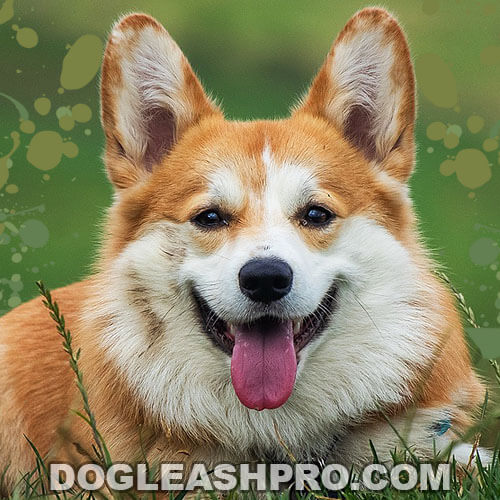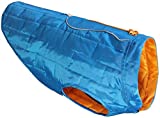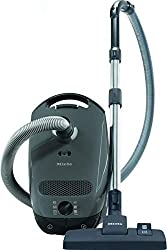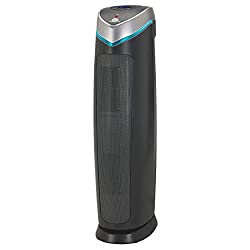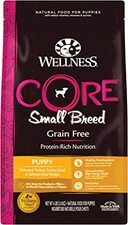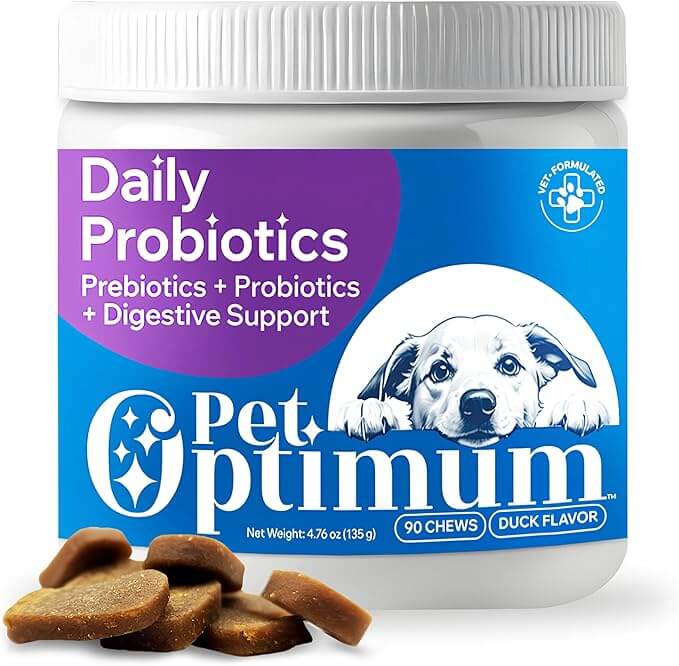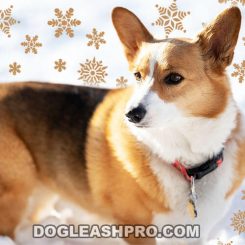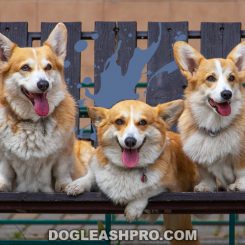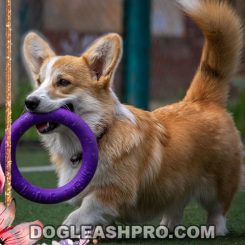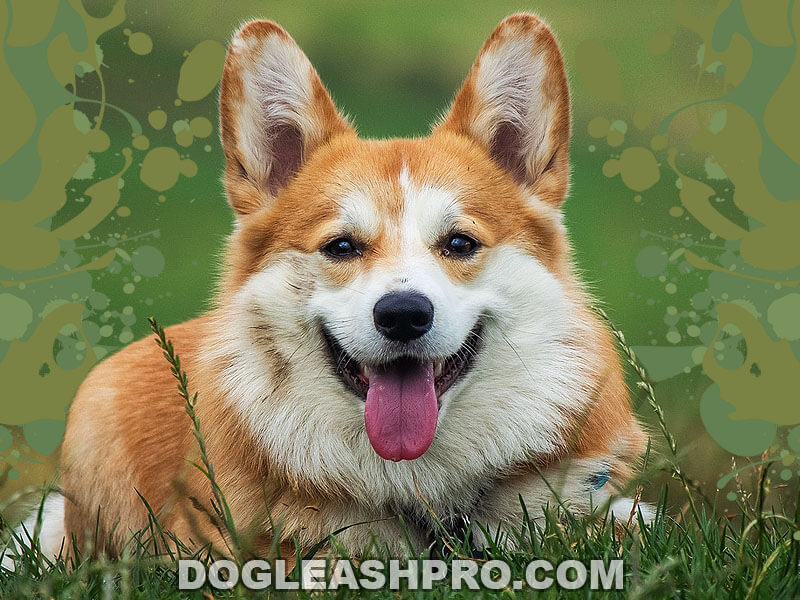
Do Corgis Shed? Yes, Corgis do shed. Corgis are a type of herding dog with a thick double coat that keeps them warm in cold climates. Corgi Shed year-round, but spring and fall are the heaviest shedding seasons. A Shedding Corgi can leave a trail of fur wherever they go. To help keep the shedding under control, it’s important to brush your Corgi regularly using a slicker brush or a de-shedding tool.
Corgis are a beloved dog breed, known for their stubby legs and friendly personalities. But one of the most important traits is their thick coat of fur. While this is undoubtedly adorable, it does mean one thing: Corgis Shed. Corgis have a double coat, which means they have both an outer coat of coarser hair and an inner coat of softer fur. The outer coat will shed year-round, while the inner coat will shed seasonally.
Due to this, Corgis are considered heavy shedders. It’s important to be aware of this if you’re considering getting a Corgi, as it means you will need to be prepared for regular grooming and vacuuming.
Fortunately, regular brushing and bathing can help keep Corgis Shedding to a minimum. This article will discuss the different types of Corgis, how much they shed and why, are Corgis hypoallergenic, and what you can do about it.
Table of Contents
Do Corgi Shed?
Yes, Corgi dog Shedding is quite common as this dog breed has a double coat: a dense, soft undercoat and a longer, coarser outer coat.
Corgi dog Shed a lot of hair throughout the year, but the amount of shedding increases during spring and fall seasons when their coats adjust to the warmer or cooler seasons. The shedding also varies for different types of Corgis, as we’ll discuss below.
Types of Corgis
Corgis are a type of herding dog that originated from Wales. Although there are a variety of colors that Corgis come in, there are only two main breeds of Corgis. The are the:
- Pembroke Welsh Corgi.
- Cardigan Welsh Corgi.
We’ll talk about each of them and how much they shed next.
Pembroke Welsh Corgi Shedding
The Pembroke Welsh Corgi is one of the oldest herding breeds in the world. These small, loyal dogs were originally bred to herd cattle and sheep, but today they make great family pets.
They are small, sturdy dogs with characteristic long bodies, short legs, pointy ears, and short tails. Their double-coat colors come in sable, red, and tricolor, with a few white markings.
Corgis are a dwarf breed, so they are small and weigh about 30 pounds. The Pembroke Welsh Corgi is known for being loyal, smart, and incredibly affectionate.
Cardigan Welsh Corgi Shedding
Cardigan Welsh Corgi got its name from its origin. This type of Corgi originated from Cardiganshire, the rocky terrain in southwest Wales.
Like the Pembroke Welsh Corgi, the Cardigan Welsh Corgi was also initially bred to herd cattle and sheep.
Cardigan Welsh Corgis have rounded, large ears and a double coat in various colors, like black, white, brindle, sable, red, and blue merle. They have a curvy structure with a sloped rear.
In terms of personality, Cardigan Welsh Corgis are introvertsthat tend to be quieter and more reserved when it comes to new people and environments. However, they warm up quickly when they get to know you.
You may be interested in: Merle Corgi (Complete Guide)
Cardigan Welsh Corgi vs Pembroke
The main difference between Cardigan Welsh Corgi and Pembroke Welsh Corgi is that Cardigan Welsh Corgi is larger and has a slightly longer body while Pembroke Welsh Corgi is smaller and shorter.
The Cardigan Welsh Corgi also has longer ears and tail, while the Pembroke has a natural tail docking.
Additionally, the Cardigan is less vocal and more independent than the Pembroke, which is more outgoing and often more vocal.
Both Corgi breeds are loyal, intelligent, and energetic, but the Cardigan Welsh Corgis are better suited to cooler temperature due to their long coat.
Do Pembroke Welsh Corgi Shed?

A common question Corgi owners typically have, especially if they are allergic to dog dander and saliva, is “Do Pembroke Welsh Corgis Shed?”
The answer is yes, Pembroke Welsh Corgis do shed. As with all double-coated breeds, Corgis will shed year-round, and will shed heavily twice a year during spring and fall.
This is when their double coat goes through seasonal changes, and the old fur needs to be replaced by new fur.
To help manage the shedding, it is important to brush your Corgi regularly and give him baths as needed. This will help keep their coat healthy and reduce the amount of fur they shed around your home.
Additionally, a good diet and exercise can help keep the shedding to a minimum.
Do Cardigan Welsh Corgis Shed?

Yes, Cardigan Welsh Corgis do shed. Like all dogs, Cardigan Welsh Corgis have a double coat, meaning they have a short, dense undercoat and a longer, coarser outer coat.
The amount of shedding can vary depending on the individual dog and his particular coat type. The Cardigan Welsh Corgi has a long outer coat and a downy undercoat that will naturally shed throughout the year.
Brushing your Corgi at least three (3) times a week will help to reduce the shedding and keep their coat looking healthy and shiny.
So, do all Corgis Shed?
Yes, all Corgis shed to some degree, although the amount and frequency can vary depending each individual dog.
Generally, Corgis have a thick double coat. The undercoat helps to insulate the dog against cold temperatures and helps to keep them cool in warmer weather.
While a Corgi’s coat can vary in length, color, and texture, they all shed year-round. The shedding tends to be more intense during the spring and summer months when their coat is thinning out in preparation for the warmer weather.
Do Corgis Shed a lot?

Yes, Corgis Shed a lot throughout the year, and their shedding intensifies in the spring and fall seasons. Pembroke Welsh Corgi and Cardigan Welsh Corgi are both heavy shedders.
As we can see, the answer to “Does Corgi Shed a lot?” is yes, Corgis shed a lot.
If you want to get a Corgi and are wondering, “Do Corgis Shed a lot of hair?” The answer is a resounding yes. Corgis Shed a lot during summer and winter as they blow their coats to adjust well to the changing seasons.
Let’s discuss how much each type of Corgi sheds.
Do Pembroke Welsh Corgis Shed a lot?
Yes, Pembroke Welsh Corgis shed all year round and they shed throughout the day. You can expect to see a lot of Corgi hair around the home and you will have to deal with the hair stuck to your clothes, carpets, and furnishings.
To reduce shedding, you should brush your Corgi at least three (3) times a week. Not only does this help with the tangles and matting, but it also keeps their coat shiny and healthy.
How much do Corgis Shed?
Corgis shed a lot, enough for you to notice their fur on your hands after you pet them. Pembroke Welsh Corgis shed lightly every day, but this intensifies to heavy shedding more than two times a year.
On the other hand, the Cardigan Welsh Corgi is an older breed of the two types that tend to shed heavily at least two times a year.
If you want to know how much do Corgi Shed to have a better idea of their shedding level before you get one, the answer is a lot.
Both types of Corgi shed all year round, and regular brushing is necessary to prevent their hair from sticking to every place in your house.
How much Do Pembroke Welsh Corgis Shed?
Pembroke Welsh Corgis shed a ton daily, which means regular brushing is important. During the spring and summer months, Corgis will shed their winter coats and produce large amounts of fur.
During these months, you should groom your Corgi regularly and brush him at least twice a week. During the winter, their coats will thicken again, and they will shed their thin summer coats.
How bad do Corgis Shed?
Compared to other dog breeds like Poodles, Maltese, and Yorkshire Terriers that don’t shed that much, Corgis shed a lot.
RECOMMENDED: Corgi Yorkie Mix (Complete Guide)
Corgi Shedding level
Corgis shedding level depends on the seasons. During the start of the winter, Corgis experience heavy shedding so that their thick undercoat can grow in to protect them from the cold weather. During these months, you will find that they are shedding heavily.
When summer approaches, Corgis will shed their thick heavy undercoat in order to stay cool, which means a lot of shedding as well.
Corgi Shedding season
| Seasons | Shedding Level |
| Spring | Heavy |
| Summer | Moderate to Heavy |
| Fall | Heavy |
| Winter | Moderate to Heavy |
Are Corgis hypoallergenic?
No, Corgis are not considered hypoallergenic dogs. That’s because they are prone to a lot of shedding, which can cause allergic reactions in those who are sensitive to pet allergy including dog dander, saliva, and fur.
For these reasons, if you or someone in your family has canine allergies, it is important to consider other dog breeds that are more allergy-friendly.
You should also know that even hypoallergenic dogs can trigger allergies in some people, so even if you choose one of the breeds known to be hypoallergenic, it is still important to do a test run before bringing a dog home.
Do Corgi puppies Shed?
Yes, Corgi puppies do shed. Corgis puppies are born with a single fur coat that starts to shed after the puppy is 4 to 6 months old. At this age, the second outer coat also starts to form and gets thicker.
When do Corgi puppies start Shedding?
Corgi puppies begin shedding their puppy coat at around 4 to 6 months old, like all puppies. Depending on the individual dog, this shedding process can take anywhere from a few weeks to several months.
During this time, the coat may change color and texture as he transitions from puppy to adult coats. Corgi puppies tend to have a thick undercoat that will need to be brushed frequently to help keep shedding under control.
Corgi coat types and colors
Corgis come in a variety of coat types and colors. The two main types of coats are long-haired and short-haired.
Long-haired Corgis have a thick, plush coat that is longer than the short-haired variety. Short-haired Corgis have a coarser coat that is typically shorter in length.
The coat colors range from white to black, with many variations in between. The most common color is red, though other popular colors include sable, brindle, black and tan, and tricolor. There are even some rarer colors such as blue merle and chocolate.
We’ll discuss Corgi coat types in more details below.
Are Corgis double coated?
If you are considering getting a Corgi, you might ask, “Do Corgis have a Double coat?”
The answer is yes, Corgis are double-coated. This means they have two layers of fur: an outer coat of coarse, straight hair and an undercoat of soft, dense fur.
The two layers work together to provide insulation and keep the Corgi warm in colder months. All corgis have a signature “uni-brow,” which is a patch of fur between the eyes that grows longer and thicker than the rest of the coat. This unique feature helps to make Corgis look even more lovable and cuddly.
Do Corgis have hair or fur?
Corgis have both hair and fur. Hair is the longer, coarser outer coat that makes up most of the coat, while the Corgi fur is the softer, denser undercoat. The hair of a Corgi is usually long and wiry, while the fur is typically more plush and dense.
Corgis typically have two layers of coat, which helps them stay warm and dry in colder months. Their fur also helps to protect their skin from the sun, as well as dirt and debris.
Long hair Corgi
Long hair Corgis can be either Pembroke Welsh Corgis or Cardigan Welsh Corgis. This type of Corgi was selectively bred to have longer fur. They are very rare because they are bred through a recessive gene.
A Corgi with long hair is also known as fluffy. These dogs are becoming increasingly popular among dog lovers as they look cute and fluffy.
Do long haired Corgis Shed? Yes, they do. Whether short-haired or long-haired, all Corgis shed year-round, with the shedding intensifying during fall and summer.
Corgi short hair
All regular Corgis have shorter hair. Like the long-haired Corgis, short-haired Corgis also shed due to their double coat, which has a top layer of long, coarse guard hairs and a soft undercoat.
The undercoat is the part that sheds more often, but the guard hairs can also fall out when brushed or when the dog is shedding his winter coat.
Short hair Corgis will shed year-round, but they typically shed more heavily in the spring and fall as they adjust to the changing temperatures.
Bald Corgi
Corgis are never bald by nature. If you want to shave them to prevent excessive shedding, that would not be a good idea. This is because Corgis rely on their coat to keep them warm in the winter months and cool in the summer months.
If you strip them of their natural insulating layer, you make them uncomfortable and unnecessarily stressed as they can no longer regulate their body temperature.
When Do Corgis Shed?
Corgis are heavy shedders due to their double coats. So, how often Do Corgis Shed?
Well, Corgis shed a lot every day of the year. Corgis typically shed heavily twice a year, once in the spring and once in the fall. During these times, they will lose their winter coats and grow in new summer coats.
You can expect your Corgi to shed more frequently and more heavily during peak shedding seasons.
To help manage the shedding, brush your Corgi regularly and keep up with regular grooming appointments. This will help keep their coat healthy and minimize the amount of shedding.
When Do Corgis Shed the most?
So, what months Do Corgis Shed the most? It is a common question posed by many Corgi owners.
Generally speaking, most Corgis will shed the most during the spring and fall seasons. This includes the months of March, April, October, and November.
During these two seasons, it is not uncommon for a Corgi to lose large amounts of fur when the weather is transitioning from hot to cold and vice versa.
For instance, during the autumn months, Corgis will shed a lot of their thinner hair and fur for the thicker coat to grow in. This will keep them warm for the winter months ahead.
In the summer months, Corgis will shed their thicker coat to allow for the thinner coat to grow in so they can stay cool.
So when Do Corgis start Shedding?
As we can see, Corgis start shedding their undercoat in the months of March, April, October, and November. The time period can vary. Usually, the heavy shedding lasts for about two to four weeks.
Do Corgis need winter coats?
Does my Corgi need a winter coat? Your Corgi might!
Corgis, like all dogs, have a layer of fur that helps keep them warm in the winter. However, depending on the climate and each individual dog, they may need an extra layer of protection during the colder months.
If your Corgi lives in a particularly cold climate or has a thin coat, it may be worth investing in a Corgi winter coat. Winter coats for Corgis come in various styles and sizes, so you can find one that fits your Corgi perfectly.
They can also help keep your Corgi warm when he is outdoor. Some coat even come with reflective strips for added visibility during nighttime walks.
Ultimately, whether or not you decide to get a winter coat for your Corgi is up to you, but it can be a good idea to keep them comfortable when walking during the colder months.
Do Corgis Shed more in the summer?
Yes, Corgis shed more in the summer. While all dogs shed to some degree, Corgis may shed more in the summer due to the increased humidity and temperature.
The higher humidity levels can lead to more sweat and oils produced by the skin, which can cause their fur to become more matted and prone to loose hairs.
Why Do Corgis Shed so much?
If you have a Corgi, you might be struggling with his shedding and can’t pinpoint why he is shedding so much.
You may be thinking “My Corgi is Shedding like crazy!” and don’t know what to do about it.
Fortunately, you’re in the right page. In the next section, we’ll discuss in detail several reasons why do Corgis Shed much more than usual, what can be triggering this, and what you can do to help.
Corgi Double coat
Corgis are known for their signature double coat, composed of a thick or fluffy undercoat and a smooth, weather-resistant top coat.
This two-layer coat helps keep them warm in the winter and cool in the summer.
However, it also means that they are prone to shedding.
On one hand, the top coat of the Corgi’s double coat is made of short, coarse hair which are easy to shed.
On the other hand, the undercoat is composed of much softer hairs that may not be shed as easily but are still prone to falling off in clumps during shedding season.
Nutrient Deficiency
Corgis can be prone to shedding if their diet lacks certain nutrients. Nutrient deficiency in Corgis can lead to several issues, including poor coat quality and excessive shedding.
When the body does not get enough of the essential vitamins and minerals it needs, it can affect the health of the coat.
In particular, a lack of proteins and omega-3 and omega-6 fatty acids can cause the fur to become dry and brittle, resulting in excessive shedding.
To prevent nutrient deficiency and excessive shedding in Corgis, you should ensure that their diet is balanced and contains all the essential nutrients.
Additionally, enough protein in their diet helps keep the Corgis’ skin elastic and their hair follicles strong which reduces shedding.
RECOMMENDED: How to Get Your Dog to Eat When Sick
Dehydration
One of the major causes of shedding in Corgis is dehydration, which can cause the fur to become brittle and break off.
When a Corgi does not receive enough water, the skin and the coat can become dry, and the fur can become brittle and easily breakable.
This can cause the fur to fall out in large clumps, known as shedding.
To help prevent dehydration-related shedding in Corgis, ensure they are properly hydrated. This means providing plenty of fresh, clean drinking water and ensuring they have access to it at all times.
DON’T MISS: What Can Dogs Drink Besides Water?
Parasites on your Corgi
Corgis, like all other dogs, can be affected by parasites. The most common parasites that affect Corgis include fleas, ticks, and worms.
Fleas are small, wingless insects that bite and feed on the blood of their hosts.
Ticks are small, spider-like creatures that attach themselves to the skin and feed on the blood of their host.
And worms are small, white, segmented organisms that live in the host’s digestive system. All these parasites can increase shedding levels because your dog will scratch himself more than usual, thus breaking hair.
To prevent parasites on Corgis, pet owners should practice regular flea and tick prevention and give their pets monthly deworming treatments.
Additionally, it is important to look for signs of parasites on your Corgi’s skin or fur and to seek veterinary advice if any are spotted. Taking these simple steps will help keep your Corgi healthy and parasite-free.
You can also get the right dog shampoo to help treat the problem. There are a variety of medicated dog shampoos that can help remove parasites quickly and effectively.
Many of these shampoos contain ingredients such as pyrethrins, permethrins, and d-limonene, which are all effective at removing parasites.
When choosing a shampoo for your K9 friends, look for one that specifically mentions that it is effective against parasites.
To protect yourself and the people around you from these fleas, you should invest in a vacuum cleaner, which sucks in and remove more than 96% of fleas.
You may also like: Engorged Tick Fell Off Dog (Here’s What To Do!)
Corgi allergies
Corgis can be prone to several allergies. Allergies in dogs can be caused by various things, including environmental allergens like pollen, dust mites, and mold, as well as food allergies.
Corgis are especially susceptible to environmental allergens, as their short fur and low-hanging bellies make it easier for allergens to come into contact with their skin. This can cause excessive shedding.
To help prevent your Corgi from developing allergies, keep their living environment as clean and allergen-free as possible.
Vacuum and dust regularly, and try to keep your Corgi away from areas with high pollen levels and other allergens.
You can also get an air purifier with a HEPA filter. This highly efficient filter filters out dust, fibers, lint, bacteria, pet dander, mold, smoke, pollen, odors, and fumes.
Additionally, it is important to watch for signs of an allergic reaction in your Corgi, such as excessive itching, redness, or swelling.
If you suspect your Corgi has an allergy, you should consult your veterinarian for proper diagnosis and treatment.
READ ALSO: Dog Losing Hair Around Eyes? (9 Top Reasons + What To Do)
Common Corgi food allergies
Corgis can suffer from food allergies. The most common food allergies among Corgis are:
Beef
Beef consists of protein, and regularly feeding beef to your Corgi can enable them to develop a food allergy or an intolerance towards it.
READ NEXT: Can Dogs Eat Beef Jerky?
Dairy
Most Corgis are lactose intolerant. That is, they aren’t able to digest lactose, a sugar found in milk. This can lead to diarrhea, vomiting, gas, or skin conditions like itchiness.
RELATED: Can Dogs Drink Ensure? Can I Give My Dog Ensure?
Eggs
The egg yolk in eggs also contains protein that your Corgi can be allergic to. Giving egg yolk to your Corgi can lead to an overwhelmed immune system.
RECOMMENDED: Can Dogs Eat Egg Salad?
Wheat
Some Corgis are also allergic to wheat, although dogs are usually prone to be more allergic to meat than to wheat or other grains.
DON’T MISS: Can Dogs Eat Wheat Thins?
Soy
Soy can cause other problems, too, apart from just allergies, such as growth and reproductive issues, liver disease, or thyroid disease.
CHECK OUT: Can Dogs Eat Soy Sauce?
Symptoms of an allergic reaction can include itching, hives, digestive problems, and excessive scratching, which results in increased shedding.
If you suspect your Corgi has a food allergy, it is important to speak to your veterinarian, who can recommend the right diet for your furry friends.
In some cases, your veterinarian may recommend an elimination diet which involves gradually introducing new foods to your Corgi’s diet to identify potential allergens.
Stress and anxiety
When Corgi is in a state of stress or anxiety, their bodies release hormones that can cause their fur to fall out more quickly. This is a natural response designed to help the body cope with stress.
In addition, anxiety can lead to excessive grooming, resulting in increased shedding. To help reduce shedding caused by stress and anxiety, ensure that your Corgi lives in a secure, calm environment and receives enough exercise and mental stimulation throughout the day.
Letting your Corgi chew on a dog bone can also relieve anxiety. This is because chewing on a meaty bone has nutritional value and provides mental stimulation.
Moreover, it releases endorphins in their system, which reduces anxiety significantly.
Hormonal Changes
Hormonal changes can affect the production of natural oils that protect the skin and fur from damage. When these oils are not produced sufficiently, the fur can become dry and brittle, leading to increased shedding.
Additionally, hormonal changes can also cause the hair follicles to weaken, which can lead to more shedding.
To prevent excessive shedding in Corgis, maintain the dog’s regular grooming routine and ensure their diet is balanced and contains plenty of essential fatty acids.
Corgi Health issues
Corgis are prone to skin conditions such as allergies, which can cause excessive shedding. As mentioned above, Corgis can suffer from hormonal imbalances, which can lead to excessive shedding in some cases.
Finally, Corgis can be prone to hypothyroidism, which can also cause excessive shedding.
In many cases, these health issues can be treated with medication or dietary changes, but it is important to consult a veterinarian for a diagnosis and a treatment plan.
If your Corgi is shedding excessively, it is important to determine the cause so that you can take appropriate steps to improve their health and reduce their shedding.
How Do I stop my Corgi from Shedding?
The first step is to make sure your Corgi is groomed regularly. This will help to remove any dead hair and reduce the amount of shedding.
Consider giving your Corgi a weekly brush, as this will help to remove any excess hair. Additionally, ensure your Corgi is drinking plenty of water, which can help keep his coat healthy and reduce shedding.
Finally, if your Corgi has been shedding more than usual, it may be time to take them to the vet. It could signify a medical condition such as allergies or parasites. If this is the case, your vet can help you find the best way to address the problem.
By following these steps, you should be able to reduce the amount of shedding and keep them looking and feeling their best.
How to take care of Corgi fur?
Brushing your Corgi’s fur thrice a week can remove dirt or debris and keep it tangle-free. Also, keep your Corgi hydrated and give him monthly baths with a dog shampoo to keep his fur clean and healthy.
A high-quality diet also ensures that the fur remains thick and fluffy.
15 Tips to manage Corgi Shedding
Here, we will discuss 15 ways you can manage Corgis shedding that will keep your home free from Corgi dander and hair and your Corgi healthy.
1. Brush your Corgi frequently
To keep your Corgi healthy, it’s important to brush them regularly. Depending on the length of your Corgi’s fur, you should brush them at least twice or thrice a week.
For longer-haired Corgis, brush them daily to prevent mats and tangles. It’s also important to brush your Corgi after they go outside, as dirt and debris can tangle in their fur.
Because Corgis shed daily, it is better to brush them every day, even when you take them to the groomer. This prevents hair from getting onto your carpets, hardwood floors, furniture, or clothing.
You can brush your Corgi anytime through the day. If you bathe him, try to brush him right after to get rid of loose hairs and avoid matting.
Hormone changes can also contribute to increased shedding. That’s because it can weaken your Corgi’s hair follicles and not produce enough oils.
Moreover, during the onset of summers and winter seasons, Corgis will experience intense shedding, and you should brush them frequently during those times.
2. Use the right tools
Using a simple or a second-rated Corgi shedding brush might not get all your dog’s fur, which is why you should spend some time choosing the right brush for your Corgi.
The different types of brushes include the following:
- Bristle brushes.
- Slicker brushes.
- Rakes.
- Grooming gloves.
A slicker brush is the most effective of the four types of brushes listed above. That’s because it can reach the Corgis’ undercoat and capture hair from there too.
A slicker brush is slightly bent, and the metal bristles are tightly spaced to remove all the hairs and debris from your Corgi’s double coat.
However, during heavy shedding seasons like the spring and fall, even a slicker brush might not be effective in getting rid of all the hairs.
During these months, it may be best to use the FURminator Corgi de-shedding tool as it is easy and comfortable to use and has a compartment that stores your Corgi’s hair when you brush. After you’re done, it releases the hair easily when you push a button.
3. Invest in a powerful vacuum cleaner
A powerful vacuum cleaner is essential if you have a Corgi, as you would have hairs everywhere otherwise. A good vacuum cleaner will eliminate all the hairs, pet dander, and other animal parasites.
4. Use a robot vacuum
Robot vacuums are designed to pick up dirt, dust, and hair from carpets and hard floors, and they can be programmed to clean your home on a regular schedule.
Some robot vacuum models even have sensors that allow them to adapt to different surfaces and detect obstacles so they won’t get stuck.
They are particularly useful for hard-to-reach places, like under furniture and around tight corners.
Plus, they are usually very quiet and can operate independently, so you don’t have to worry about manually cleaning up after your Corgi.
A robot vacuum cleaner can make cleaning up after your Corgi much easier, giving you more time to enjoy your time with your furry companion.
5. Use an air purifier with HEPA filter
One of the best ways to combat Corgis hair in the air due to shedding is by investing in an air purifier with a HEPA filter.
HEPA filters in air purifier captures and removes small particles like pollen, dust, and pet dander from the air. This makes them ideal for Corgi owners, as they can help reduce the amount of fur or dander in the air.
Additionally, many air purifiers with HEPA filters include features like activated carbon filters and UV light filters that can help remove odors and kill germs.
Investing in an air purifier with a HEPA filter is one of the best ways to keep the air in your home clean even when your Corgis shed.
6. Stock up on lint rollers
To keep your home fur-free, it’s a good idea to get some lint rollers. Lint rollers are easy to use and can quickly pick up fur from your clothes and furniture without leaving a sticky residue.
Use a lint roller with a long handle to reach hard-to-reach spots like under furniture and in tight corners.
The great thing about lint rollers is that they are relatively inexpensive, so you can buy a few packs and keep them around the house for quick fur clean-ups.
With a lint roller, you can keep your home fur-free and enjoy your adorable Corgi without the mess.
7. Avoid bathing your Corgi too often
You should bathe your Corgi once a month and bathe only when they are very filthy. That’s because bathing them too often can actually strip their skin and fur from their natural oils which increases the amount of shedding.
The natural oils also protect your Corgi from the changing seasons. You can use dry shampoo or grooming pet wipes to clean your dog in between baths. You can also use a wet towel to run over them.
How often should you bathe a Corgi?
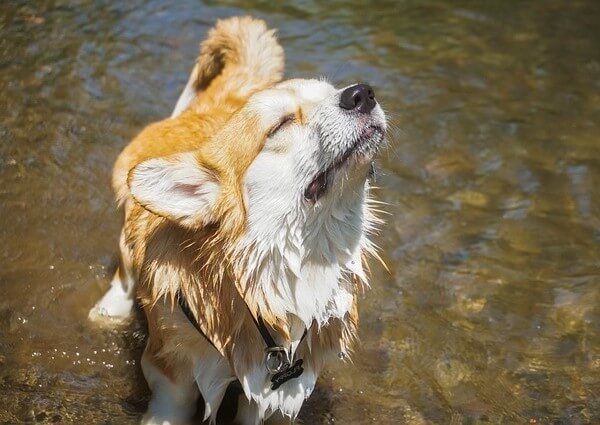
As a Corgi owner, it is common for you to ask, “how often should I bathe my Corgi?”
Depending on how filthy they are, you can bathe your Corgi once or twice a month. As mentioned above, don’t overdo it to protect their natural oils and limit shedding.
8. Using the right dog shampoo
The best dog shampoos for Corgis that sheds a lot contain natural ingredients such as oatmeal, aloe vera, and coconut oil. These ingredients help nourish the skin and coat while reducing inflammation and providing antifungal and antibacterial protection.
It’s also important to look for shampoos designed specifically for dogs, as human shampoos can be too harsh for their sensitive skin.
9. Nutritious and high-quality dog food is a must
Look for food specifically designed for Corgis and contains high-quality proteins and other essential nutrients. It should also be free of unnecessary fillers and preservatives.
For Corgis, the ideal diet should include lean proteins, healthy fats, complex carbohydrates, vitamins, minerals, and omega-3 fatty acids.
Some ingredients to look for include chicken, lamb, fish, brown rice, sweet potatoes, apples, and blueberries.
To ensure your Corgi gets all the necessary nutrients, consider supplementing his diet with vitamins and minerals which we will discuss next.
10. Taking the right supplements for healthy skin and coat
Various dietary supplements are available to help meet your Corgi’s nutritional needs and keep his skin and coat healthy.
Essential fatty acids such as omega-3 and omega-6 are important for maintaining a healthy coat, so look for supplements that contain these.
Vitamin E is also beneficial for skin and coat health and can be found in supplements such as natural oils.
Additionally, probiotics help support a healthy immune system, which can prevent skin problems.
11. Exercise, exercise, exercise!
Exercise helps to control Corgi shedding by keeping the Corgi’s coat healthy and in good condition. Regular exercise helps to stimulate blood circulation and distribute essential oils throughout the coat.
This helps keep the coat strong, shiny, and healthy, preventing excessive shedding.
Additionally, exercise helps to reduce stress in Corgis, which is also a factor that causes shedding.
Finally, exercise can help to strengthen your Corgi’s immune system, which can help fight off any skin infections that may be causing excessive shedding.
To keep a Corgi’s coat healthy, give them at least 30 minutes of exercise per day. This can be anything from a walk to playing fetch in the backyard.
When walking your furry friends be sure to use a retractable dog leash which will allow them the space to explore while still under your full control.
12. Bring your Corgi for his regular vet check-up
Regular vet check-ups are important as your vet can ensure that your Corgi is healthy and has no underlying health issues, such as allergies or parasites causing excessive shedding.
13. Trim when needed, but never shave!
Shaving your Corgi can strip them of their natural insulation layer that is responsible for regulating their body temperature, staying cool in the summers, and staying warm in the winters.
You can trim your Corgi’s hair to manage shedding, however, shaving them is not a good idea as your Corgi will be uncomfortable and unnecessarily stressed afterward.
Can you shave a Corgi?
No, shaving a Corgi is not a good idea. Corgis have a double-layer coat that helps keep them warm in cold climates, and shaving it off could leave them more vulnerable to the elements.
Additionally, shaving a Corgi could create new problems. Their fur grows back quickly, but it will be softer and fluffier. This could lead to an even thicker coat, which could cause your Corgi discomfort.
It is best to leave your Corgi’s coat alone and brush it regularly to help keep it healthy and free of mats and tangles.
Do Corgis need haircuts?
Do Corgis get haircuts? Long-haired Corgis might need haircuts or trims to keep their unruly coats in shape and prevent them from getting too dense, which can lead to excessive shedding.
Corgis should be given a haircut at least once a year to keep their coat healthy and free of tangles and mats.
A Corgi summer cut can help keep your Corgi cooler in the warmer months. A professional groomer can give your Corgi a trim to keep them looking their best.
However, if you decide to do the grooming yourself, ensure you use the appropriate tools and techniques for the job.
It’s also important to trim the fur around the ears, eyes, and pads of the feet to prevent dirt and debris from collecting. If done correctly, regular grooming can help keep your Corgi happy and healthy.
DON’T MISS: Dog Grooming For Beginners At Home (Dos and Don’ts)
Trim your Corgi’s nails
Letting your Corgi outgrow hiss nails can lead to scratches on your sofas, couches, and furniture. Corgis can also give you some nasty scratches that can cause an infection or pain.
Longer nails can take out more hair than normal when Corgis scratch themselves, leading to excessive shedding. Try to trim your Corgi’s nails every 3 to 4 weeks with a dog nail grinder or a dog nail clipper.
14. Spay or neuter your Corgi
Spaying or neutering your Corgi is a great way to reduce shedding. When your K9 friends are spayed or neutered, their hormone production decreases, which can lead to less shedding.
This is especially beneficial if you live in an area with hot weather, as the reduced hormones can make your pet more comfortable in the heat.
Additionally, spaying or neutering your pet can help prevent certain health problems, such as cancer and other reproductive issues and reduce the risk of them developing certain behavioral problems.
15. Accept Corgi hair as a part of your life
Finally, no matter what reasons you look for, you should accept that your dog will always be shedding even if he isn’t undergoing some health issue. Corgis shed all year round, and Corgi owners should get on board with that if they want to enjoy their time with their dogs.
Are Corgis bad for allergies?
Whether or not Corgis are bad for allergies depends on the individual. Corgis have a double coat of fur, which can make them prone to shedding and dander. This can make them difficult to live with for people who have allergies or asthma.
If you decide to get a Corgi, you should brush them regularly and keep their environment as clean and dust-free as possible.
Additionally, some hypoallergenic breeds of dogs may be a better choice for allergy sufferers, such as Poodles or Bichon Frises.
Corgi grooming
How often do Corgis need to be groomed?

How often should Corgis be groomed depends on the level of nutrition, supplements, and hydration you provide to your Corgi.
Even then, Corgis require grooming after every four to eight weeks, where you need to bathe your Corgi, trim his hair and nails, and brush his coat. That said, regular brushing is still important to control shedding in Corgis.
Do Corgis need professional grooming?
Professional grooming may be necessary depending on the type of Corgi you have.
For example, if your Corgi has a longer coat, it is important to take him to a professional groomer every few months. Professional groomers can trim and style your dog’s coat to keep him looking neat and healthy.
Additionally, professional groomers are trained to identify skin conditions or parasites that may be present on your Corgi’s coat.
For these reasons, it is worth investing in professional grooming services to groom Corgi. A groomed also Corgi looks and feels much better.
Grooming Corgis properly to reduce Corgi Shedding
Brushing your Corgi daily or at least three times a week is essential to control shedding. However, proper grooming can take place after every month or two.
Use tools like slicker brushes and other de-shedding tools while grooming Corgi to eliminate excess hair on your pooch. It also helps distribute natural oils throughout the fur, keeping him healthy.
During heavy shedding seasons, it’s best to use a de-shedding tool for your Cardigan Welsh Corgi grooming. When the compartment fills up with hair, push the button to empty it.
Keep brushing for at least 15 to 20 minutes until you see very little hair in the compartment.
For regular shedding all year round, you can use the slicker brush to get rid of any loose hair.
Is there a Corgi that doesn’t Shed?
It is rare to find Corgis that don’t Shed, however, mixed-breed Corgis shed less than the purebred types.
Corgis that don’t Shed as much as the purebred ones include the Schnauzer Corgi mix or the Shih Tzu Corgi mix. These mixes result in a non Shedding Corgi or Corgis that don’t Shed a lot because Schnauzers and Shih Tzus are both hypoallergenic breeds.
Do fluffy Corgis Shed?
Yes, fluffy Corgis do shed. But, do fluffy Corgis Shed less?
Yes, fluffy Corgis do shed less. While they may not shed as much as some other dog breeds, they still shed an average amount, with the shedding levels increasing during the fall and spring.
Do teacup Corgis Shed?
Yes, teacup Corgis do shed. Teacup Corgi is a miniature Corgi dog by mixing Corgis with other breeds. Like normal Corgis, they have a double coat of fur that sheds regularly.
Teacup Corgis usually shed in the spring and fall when the temperature changes, but they can also shed year-round depending on the weather.
They are considered a low-shedding breed, meaning they don’t shed as much as other breeds, but they still need regular grooming to keep their coats healthy and free of tangles.
Do Cowboy Corgis Shed?
Yes, Cowboy Corgis do shed. They are a mix of Australian Cattle Dogs and Pembroke Welsh Corgis. Simply put, Cowboy Corgi is a Blue Heeler Corgi Mix, and both breeds are known to shed heavily.
However, there is a wide range of shedding levels among individual Cowboy Corgis, as every dog is different.
Some Cowboy Corgis may shed seasonally, while others may shed year-round. Generally speaking, you should expect them to shed moderately to heavily.
So, Do Corgis Shed?
In conclusion, Corgis do shed a lot. But you can manage their daily shedding levels by brushing them regularly and taking care of their diet and hydration levels.
A powerful vacuum cleaner can keep your home free from Corgi hair, while a good de-shedding tool and brush can keep your Corgi coat healthy.
Related Questions
Not exactly. They do require a lot of brushing and professional grooming once in a while, but apart from that, Corgis are fairly easy to live with.
DISCLAIMER: THIS WEBSITE DOES NOT PROVIDE MEDICAL ADVICE
The information, including but not limited to, text, graphics, images and other material contained on this website are for informational purposes only. No material on this site is intended to be a substitute for professional veterinary advice, diagnosis, or treatment. Always seek the advice of your veterinarian or other qualified health care provider with any questions you may have regarding a medical condition.
Resources:
https://www.ncbi.nlm.nih.gov/pmc/articles/PMC3842694/
https://cardiganhealth.com/research/
https://vgl.ucdavis.edu/breed/pembroke-welsh-corgi

With over five years of specialized experience as an animal writer, my expertise lies in dog nutrition, health, behavior, grooming, and training. I am dedicated to delivering helpful and informative content that caters to the well-being of our furry friends. My primary goal is to empower pet owners with knowledge and ensure our canine companions thrive in health and happiness. In my free time, I love volunteering at local dog rescue centers.
